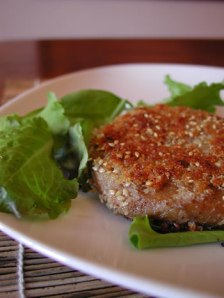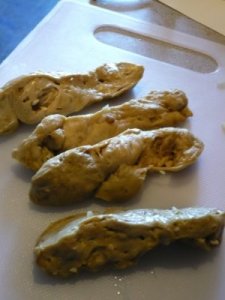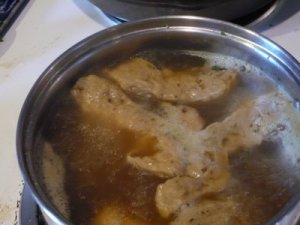Wheat Gluten, commonly called “wheat meat” or Seitan, is a great staple to your food storage. As I addressed some of the whys and wherefores of “wheat meat” yesterday, today I’m going to share with you HOW to create your own wheat gluten. Just to get your imagination going here, you can make countless WONDERFUL dishes with “wheat meat” in place of your traditional fare. “Meatballs,” “ground chicken or beef,” “steak slices,” “ham,” “sausage”, etc., can all be deliciously created from your wheat storage.
12 cups of whole wheat flour will yield about four cups of raw gluten, varying slightly based on the quality of your wheat and its protein content. Hard red wheat or wheat from cold climates will produce the most amount of gluten. Four cups of raw gluten will then bake into about nine cups of ground gluten which is equivalent to about three lbs. of cooked hamburger, 150 “meatballs”, or 20 “steak slices.”
For my meat loving readers, a good way to introduce “wheat meat” into your diet is to add it to your ground beef/chicken dishes at present. Start with half meat and half gluten. (This works well to indoctrinate not only into the meal, but also into the digestive system if you’re not already eating wheat.) Being married to a major meat eater, I’m confident that you’ll easily be able to go to a ¼ meat to ¾ gluten ratio in no time, with little or no resistance. And then of course move on to full fledged meals with the “wheat meat” as your only source. The nice part about “wheat meat” is that it doesn’t have a definitive taste or color. It readily takes on the appearance and flavors of what you cook with it.
Keep in mind that I’m not writing about using commercial wheat gluten. You prepare commercial wheat gluten differently than when you use your own whole wheat/flour. The last thing I want to do is put one more thing on your list to store, such as commercial gluten. Good news is that storing commercial gluten is not necessary if you’ve got a good supply of wheat. Your flour contains raw gluten. All you have to do is extract it from the flour. Fortunately, that takes very little effort on your part.
To begin preparing your “wheat meat”, simply mix 12 cups of whole wheat flour (you can use white flour as well, but you won’t get as much gluten) with 7 cups of water. You can do this in a mixer, or you can do it by hand. If you use a mixer, this process will only take you about 5 to 10 minutes. The consistency you want to end up with is flexible. It’s going to look a lot like your bread dough does before being completely kneaded. You don’t want dry, or watery. You want it to look a bit rubbery. You can adjust the amounts of flour or water after your initial mixing in order to get the consistency you need. When you’re finished mixing this together, set it aside and cover the surface with plastic wrap or a towel to ensure that it doesn’t dry out. Let it rest for about 20-30 minutes. If you have to ignore it longer than that, then I would refrigerate it.
Now, place your dough in a colander/strainer over an empty bowl in the sink. I prefer a metal colander. For about 5 to 7 minutes, run lukewarm water over your dough. You want a slow flow on your water and you want to be sure that you have a bowl underneath your strainer to collect the water. (There are a whole lot of uses for this precious mineral/vitamin rich water. So don’t throw it out.) As the water is running you want to continue squeezing the dough and working with it in order to squeeze out all of the starch. You will know that you’re done squeezing the dough when the water coming through the strainer is no longer coming out a milky color. Rather it will be clear. As you’re working with the dough, you will begin to create a rubbery ball. Continue to work the gluten into a ball as the starch separates from the gluten. Your final ball won’t look very beautiful. It won’t look like a ball of bread dough because it doesn’t have any air in it. It will simply be a dense, rubbery ball of gluten mass. (Sound appetizing yet? Don’t worry. It gets better, I promise!) Here’s one thing I do want to share that I had to learn the hard way. Just before your dough is the right ball consistency when you’re rinsing it, it gets a bit stringy. It’s easy to think that you’ve messed up. But actually this is just the “storm before the rainbow.” Once the stringy-ness occurs, you’ll know you’re close to being finished with perfect gluten! Once you’ve got your ball of gluten, you’ve done the “hard work.”
What you want to do at this point is to cook the gluten prior to adding it into your preferred dish. There are two ways to cook your gluten at this point—steaming it and simmering/boiling it.
The steam method is ideal for shaping your gluten into familiar shapes and textures. You simply form it into the shape that you want by hand, or wrap it in cheesecloth, and then place it in a vegetable oil-sprayed steamer. (Just like the instrument you would use to steam your vegetables in.) You can cook the entire ball of “meat” this way, or you can shape it into smaller portions. Place the steamer in a pot of boiling water and steam your gluten for about 30 minutes.
The boiling method is also easy and it adds extra flavor to your “meat.” In this instance I prefer to cut my gluten into smaller pieces so as to season them well. Simply drop your strips or pieces of gluten into a pot of boiling, flavored broth. Simmer for about 30 minutes. It will just about double in size in this method. You can simply use a broth made with bouillon cubes, or you can create your own. Here’s my favorite broth to start out with.
- 10 cups of water
- About a cup of soy sauce or Braggs Amino Liquids
- 2 bay leaves
- A t. of garlic powder
- A t. of onion powder
Slice your gluten into small pieces, about the size of chicken nuggets. Place them in the hot water and continue to simmer for about 30 minutes.
From this point you’ll discover the fun of creating “meat” out of “wheat”. You can now chop, grind, slice, steam, marinade, sauté, smoke, BBQ, or fry your “wheat meat”. The “trick” is all in how you prepare it visually and how you season it. It’s that simple—REALLY! (You can store your “wheat meat” in the fridge for the same amount of time that you would “regular” meat.) You’re now ready to cook the gluten as you would any of your other protein sources. I like to fry it in a bit of oil or butter until it’s golden brown on both sides, and then add a bit of BBQ sauce and let it simmer for a few minutes. It tastes like tender chicken or beef. I also like to grind up my steamed “meat” and use it instead of ground beef or chicken in my meatloaf, soup, burger, casserole, or chili recipes. I especially like how the “ground sausage” turns out.
I also like to bread it with Panko bread crumbs, salt and pepper, and then serve a yummy, brown gravy over my “wheat meat”, just like chicken fried steak.
I also enjoy sprinkling slices of Monterey Steak Seasoning on it and then grilling it. It’s even better after I let the “wheat meat” marinade in a steak marinade first.
Dang. I’m getting hungry. I’m going to sign off for now and go make some “wheat meat” for myself. I’ll share some detailed recipes for “wheat meat” with you on Monday, and I’ll also share some great ways to use the left over starch water with you next week as well! In the meantime, give this a try by making your own “wheat meat” this weekend.
Wheat Meat Series
To see our upcoming event schedule, click here
Check out our inhome-course programs
Subscribe to Preparedness Pro today and never miss a thing!
For any questions or comments on this article, please leave a comment on the blog site so that everyone can benefit!
Copyright Protected 2009, Preparedness Pro and Kellene. All Rights Reserved. No portion of any content on this site may be duplicated, transferred, copied, or published without written permission from the author. However, you are welcome to provide a link to the content on your site or in your written works.








30 Comments
AmyH · August 14, 2009 at 6:53 pm
I cannot wait to try this! I just started eating vegetarian a little over two months ago and am looking for tasty alternatives to meat.
Thanks for this info! 🙂
AmyH · August 14, 2009 at 6:53 pm
I cannot wait to try this! I just started eating vegetarian a little over two months ago and am looking for tasty alternatives to meat.
Thanks for this info! 🙂
GLRichards · August 15, 2009 at 4:04 am
Wow, I am going to give this a try. This could really help save big on the family food budget. I’am looking forward to more recipes.
GLRichards · August 15, 2009 at 4:04 am
Wow, I am going to give this a try. This could really help save big on the family food budget. I’am looking forward to more recipes.
Queenbuffness · August 15, 2009 at 10:40 am
This sounds like the perfect solution for hubby’s 200# of wheat purchase this spring!! How do I store the gluten? Freeze? And is this the same type gluten stores sell to add to whole wheat bread recipes to help them rise and be lighter?? Have you used it this way?
Queenbuffness · August 15, 2009 at 10:40 am
This sounds like the perfect solution for hubby’s 200# of wheat purchase this spring!! How do I store the gluten? Freeze? And is this the same type gluten stores sell to add to whole wheat bread recipes to help them rise and be lighter?? Have you used it this way?
Anna · August 15, 2009 at 1:10 pm
Thanks for the directions. Many, many years ago, I gave this method and try and I could never figure it out. It seemed like when I rinsed it, I would lose a lot of the “dough”. So, I gave up.
Recently, I have tried this method with much success. The only down side is having no “shaped” “meat”.
I may have to give this method you posted another try. Thanks again!
Anna · August 15, 2009 at 1:10 pm
Thanks for the directions. Many, many years ago, I gave this method and try and I could never figure it out. It seemed like when I rinsed it, I would lose a lot of the “dough”. So, I gave up.
Recently, I have tried this method with much success. The only down side is having no “shaped” “meat”.
I may have to give this method you posted another try. Thanks again!
Kellene · August 15, 2009 at 4:09 pm
You don’t want to “store” the gluten. Just make it and use it as you need it. Yes, this is the same type of gluten that you end up with. You’ll see much more on Monday. 🙂 You dont’ need to use gluten in your bread flour unless you have older flour. So, no. I don’t use it. I use dough enhancer and lecithin granules. Do a search on bread recipe here and you’ll see my bread recipe that ALWAYS turns out.
Kellene · August 15, 2009 at 4:09 pm
You don’t want to “store” the gluten. Just make it and use it as you need it. Yes, this is the same type of gluten that you end up with. You’ll see much more on Monday. 🙂 You dont’ need to use gluten in your bread flour unless you have older flour. So, no. I don’t use it. I use dough enhancer and lecithin granules. Do a search on bread recipe here and you’ll see my bread recipe that ALWAYS turns out.
Kellene · August 15, 2009 at 4:11 pm
You will lose a lot of the dough. That’s just what happens when you separate the starch from the gluten. (that’s why the gluten you buy in stores is so expensive) But dont’ give up. This is a “God send” in my opinion when it comes to wondering how you will have room for all of that meat. 🙂
Kellene · August 15, 2009 at 4:11 pm
You will lose a lot of the dough. That’s just what happens when you separate the starch from the gluten. (that’s why the gluten you buy in stores is so expensive) But dont’ give up. This is a “God send” in my opinion when it comes to wondering how you will have room for all of that meat. 🙂
Dani · August 15, 2009 at 8:17 pm
Being gluten intolerant, reading an article about wheat gluten makes me cringe. But thank you for sharing this, because in an emergency I’m not the only one I need to prepare for. I’ll have to try making it for the hubby and let you know what he thinks! Thanks!
Dani · August 15, 2009 at 8:17 pm
Being gluten intolerant, reading an article about wheat gluten makes me cringe. But thank you for sharing this, because in an emergency I’m not the only one I need to prepare for. I’ll have to try making it for the hubby and let you know what he thinks! Thanks!
Debbie Olson · August 16, 2009 at 2:42 pm
I cant seem to print the article for my records. IT wont let me. Is this not allowed?
Thanks,
Debbie
Debbie Olson · August 16, 2009 at 2:42 pm
I cant seem to print the article for my records. IT wont let me. Is this not allowed?
Thanks,
Debbie
Kellene · August 16, 2009 at 6:01 pm
Debbie, I’m not technically smart enough to manipulate the permissions on this. I certainly didn’t “try” to omit that possibility. I’m sure you can “print” them though as a screen shot, but you’ll need to ask someone who’s smarter than me as to how to do that. Good luck!
Preparedness Pro · September 3, 2013 at 5:10 pm
I cook it just like I do
I cook it just like I do ground beef. It’s in smaller pieces like the ground beef and seasoned accordingly.
Kellene · August 16, 2009 at 6:01 pm
Debbie, I’m not technically smart enough to manipulate the permissions on this. I certainly didn’t “try” to omit that possibility. I’m sure you can “print” them though as a screen shot, but you’ll need to ask someone who’s smarter than me as to how to do that. Good luck!
Preparedness Pro · September 3, 2013 at 5:10 pm
I cook it just like I do
I cook it just like I do ground beef. It’s in smaller pieces like the ground beef and seasoned accordingly.
Kellene · August 16, 2009 at 6:02 pm
Dani, guess what. I’m doing some great research on the “wheat meat” you can make with the non-gluten foods. I’m going to have to try them for myself before sharing them. But I think it will be really helpful for you and others who are in the same boat.
Dani, guess what. I’m doing some great research on the “wheat meat” you can make with the non-gluten foods. I’m going to have to try them for myself before sharing them. But I think it will be really helpful for you and others who are in the same boat.
Kellene · August 16, 2009 at 6:02 pm
Dani, guess what. I’m doing some great research on the “wheat meat” you can make with the non-gluten foods. I’m going to have to try them for myself before sharing them. But I think it will be really helpful for you and others who are in the same boat.
Dani, guess what. I’m doing some great research on the “wheat meat” you can make with the non-gluten foods. I’m going to have to try them for myself before sharing them. But I think it will be really helpful for you and others who are in the same boat.
jamie · September 11, 2009 at 3:28 am
To copy this article just highlight what you want to print Go up to File, you should get a drop down menu Select Print.
I am using Fire fox for my Browser.
Or you could just copy and paste into word document and print it from there.
jamie · September 11, 2009 at 3:28 am
To copy this article just highlight what you want to print Go up to File, you should get a drop down menu Select Print.
I am using Fire fox for my Browser.
Or you could just copy and paste into word document and print it from there.
Rachel · January 29, 2010 at 2:23 am
I have wheat in Sam Andy cans that are over 35 years old. What are the chances that it can be used to make wheat meat?
Kellene · January 29, 2010 at 3:34 am
I certainly would try it if it were me, Rachel.
Rachel · January 29, 2010 at 2:23 am
I have wheat in Sam Andy cans that are over 35 years old. What are the chances that it can be used to make wheat meat?
Kellene · January 29, 2010 at 3:34 am
I certainly would try it if it were me, Rachel.
Kate · September 3, 2013 at 3:36 pm
Can you be more specific on
Can you be more specific on how you grind up your steamed “meat” and use it instead of ground beef?
Kate · September 3, 2013 at 3:36 pm
Can you be more specific on
Can you be more specific on how you grind up your steamed “meat” and use it instead of ground beef?
Comments are closed.